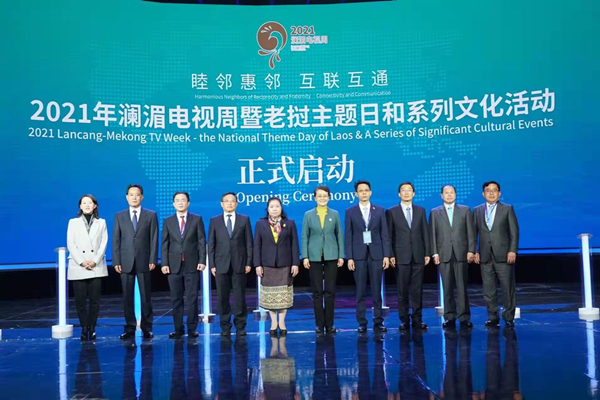
Manila Sombandith, consul-general of Lao People's Democratic Republic in Kunming, Yunnan province, takes part in the opening ceremony of the 2021 Lancang-Mekong TV Week in Kunming on Dec 1, 2021. [Photo/chinadaily.com.cn]
The Lao economy is projected to grow by 4.2 percent in 2022, driven by exports and opportunities and benefits arising from the China-Laos Railway, according to a latest report.
The rail link, which became operational on Dec 3, will enable Lao products, notably agricultural goods, to have better access to the Chinese market, said the report from the Lao National Economic Research Institute.
As of Wednesday, the total value of the imported and exported goods along the China-Laos Railway reached 107 million yuan ($16.8 million), according to data from the Kunming Customs.
As of Thursday, the number of passenger trips on the Chinese section of the line hit more than 300,000, China Railway Kunming Bureau Group Co said.
The railway put Laos in the global spotlight, providing much-needed rail connectivity and using the country's landlocked location to develop strong overland transport links, local daily Vientiane Times reported on Thursday.
In an exclusive interview with China Daily, Manila Sombandith, consul-general of Lao People's Democratic Republic in Kunming, Yunnan province, shares her views on the newly opened China-Laos Railway.
Following are excerpts from the interview:
Q: How will the railway benefit Laos and Laotians?
Sombandith: The infrastructure development is one of the priorities of the Lao government. Large-scale infrastructure investment projects have become an important starting point for the transition from our dependence on natural resource exploitation to enhancing the nation's new potential through sustainable, green development.
The project will transform Laos from a land-locked to a land-linked country that will make a significant contribution to the implementation of the Lao government's socioeconomic development plan to accelerate poverty eradication.
The Lao people are happy that their dream of a high-speed railway has come true. This will be a turning point in prosperity. I do hope that this historic Laos-China Railway will stimulate the economic growth of Laos to new heights, improve the Lao people's livelihoods and help Laos in poverty eradication.
Q: How will the railway promote cooperation between China and Laos?
Sombandith: The railway project will definitely benefit both countries and peoples, as it will facilitate communication, tourism and investors in both countries with comfort and less time. It will also promote tourism and stimulate the economic growth of the two countries.
Economic cooperation is a driving force that has been fruitfully growing and continuously expanding, especially in the trade and investment sectors. Currently, China is the second-largest trading partner and the largest foreign investor in Laos.
The Kunming-Vientiane Railway will become a key channel connecting our two countries and is expected to improve trade links because it will facilitate the movement of goods.
The Laos-China Railway project is outstanding and the largest cooperation project between the two countries. This project is significant as it marks the beginning of the implementation of the master plan of community building with a shared future and contributes to the building of an economic corridor between the two countries. It is a symbolic project under the Belt and Road Initiative and a milestone of friendship in the new era. This is one of the key projects under the Asia Sub-Regional Integration Strategy, Mekong-Lancang Cooperation — and especially between Laos and China.
Q: What is your view of the significance of the railway in Southeast Asia and the Belt and Road Initiative?
Sombandith: This railway will contribute not only to strengthening relations between Laos and China but will also take China-ASEAN relations to new heights. Apart from that, the railway will inject a new momentum into the economic growth of Southeast Asia, which will draw attention from people around the world. Laos-China relations will become a good example for international relations in the region and the world at large.
The Laos-China Railway will make a great contribution to the Master Plan on ASEAN Connectivity and integrate the Southeast Asian region with China, which will bring enormous benefits to the people of the region.
I am of the view that the Belt and Road Initiative has encouraged and promoted intergovernmental cooperation, policy exchanges and communication mechanisms with win-win cooperation. Moreover, the BRI has created opportunities for the improvement of connectivity in transportation infrastructure and technical systems in the region. Therefore, we strongly believe that the BRI will bring more opportunities for participating countries.
Q: Can you share your personal feelings about the event?
Sombandith: The launching ceremony of the Laos-China Railway on Dec 3 was a historic milestone that makes me proud of my diplomatic assignment here — one that will remain in my memory forever.
I am lucky to have been appointed as Lao Consul General to Yunnan province, which is a starting point linking Laos and China, a hub to connect China with South and Southeast Asia and a province that actively implements a master plan for community building with a shared future in the Laos-China economic corridor.
Also, I am lucky to have had an opportunity to participate in this historic event — the official launch of the Laos-China Railway — on Dec 3. I also participated in various forums and activities in connection with the event, which further deepens Laos-China relations. The year 2021 is a lucky year for me.